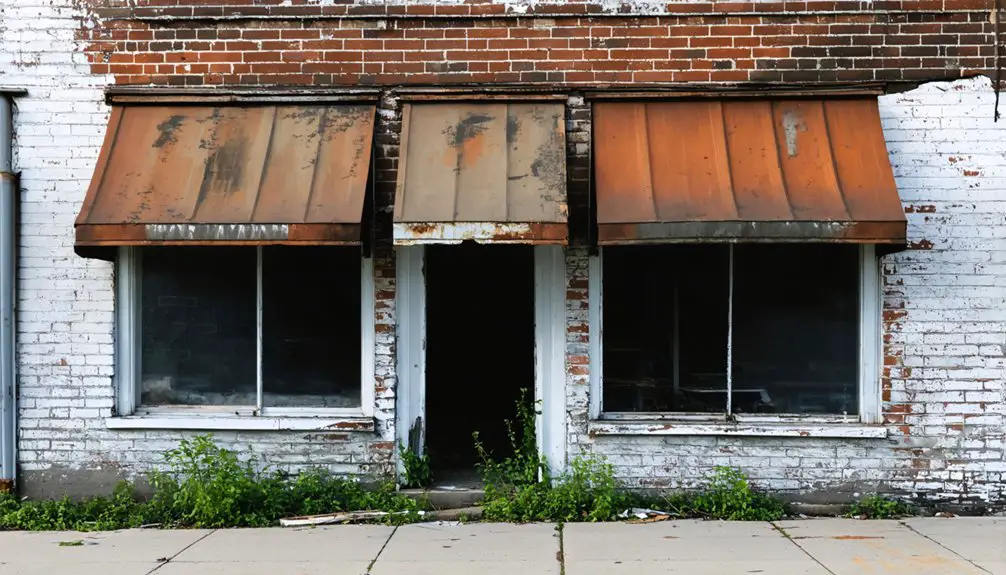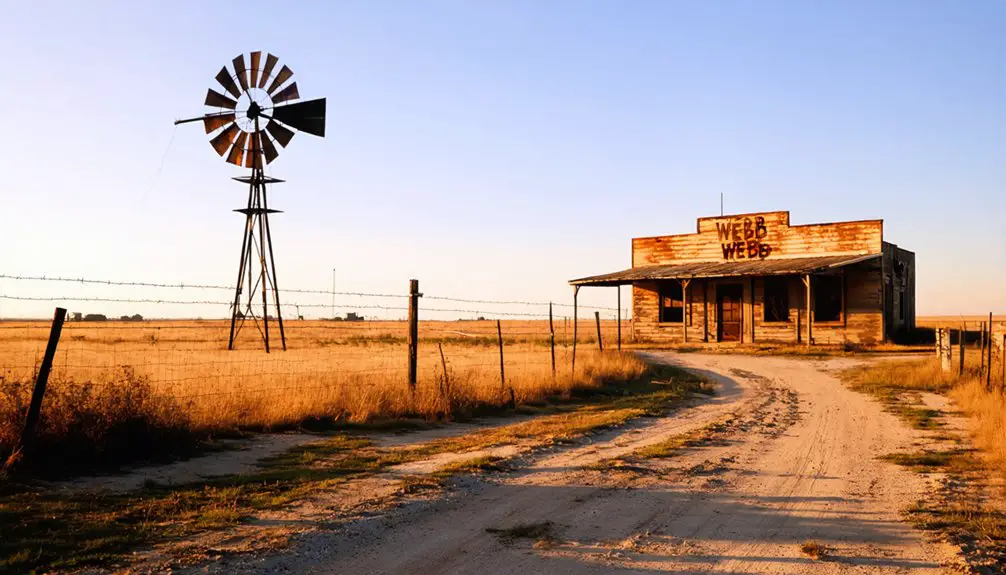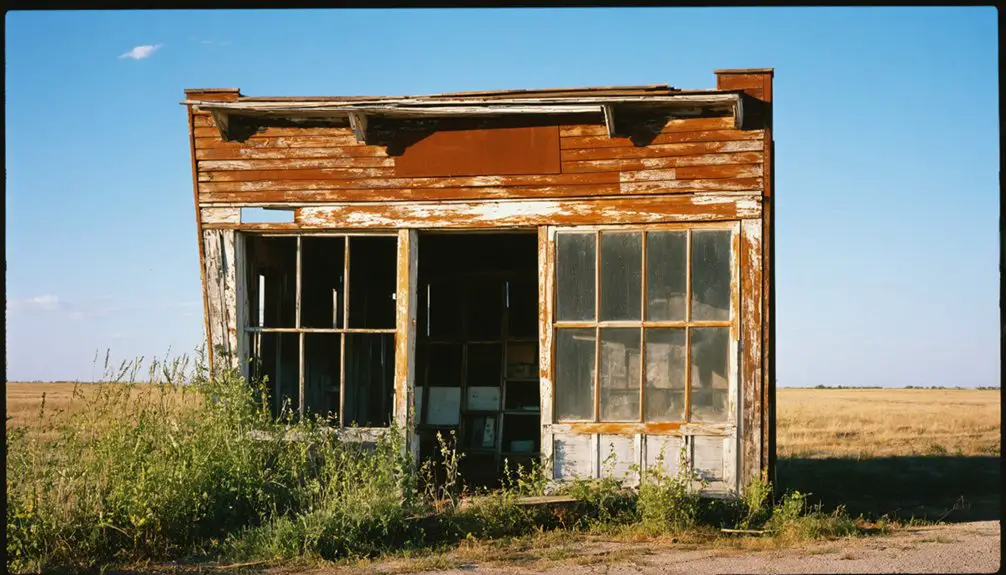You’ll discover Webb, Oklahoma’s fascinating transformation from Horace Webb’s farmland into a bustling oil boomtown in 1921. The discovery of the Burbank Field, combined with Phillips Petroleum’s presence and the arrival of Route 66 in 1926, turned this settlement into a crucial transportation hub. While most buildings now stand empty along Main Street, the historic 1924 brick schoolhouse and active church community keep Webb’s spirit alive, offering glimpses into its oil-rich past.
Key Takeaways
- Webb began as an oil boomtown in 1921 following the discovery of the Burbank Field in Oklahoma.
- The town flourished due to Phillips Petroleum’s operations and the strategic intersection of Route 66 and Osage Railway.
- Economic decline followed industry shifts and Phillips Petroleum’s 2002 merger, leading to population loss and abandonment.
- The 1924 brick schoolhouse remains a prominent landmark along Main Street, echoing Webb’s prosperous past.
- Local churches continue to serve surrounding rural areas, preventing complete abandonment of the former boomtown.
The Birth of an Oil Boomtown
While many Oklahoma oil boomtowns sprouted up during the early 1920s, Webb’s story began with the discovery of the promising Burbank Field.
You’ll find Webb’s oil boom roots traced back to a simple oil camp that transformed into a proper townsite in 1921 on Horace Webb’s land. Like the high-yield oil claims that enticed investors in other Oklahoma fields, the promise of black gold drew hopeful settlers to the area. As drilling operations expanded, you’d have witnessed the town’s rapid evolution from a temporary settlement to an established community, marked by its post office opening on December 16, 1922.
The community’s resilience showed in its swift development. When Phillips Petroleum secured drilling rights, Webb became a crucial hub at the northwestern edge of the Burbank field. Similar to nearby Whizbang, the area saw wells producing up to 2,500 barrels daily.
You’d have seen the town grow as workers and their families poured in, contributing to a bustling atmosphere of opportunity and enterprise.
Horace Webb’s Legacy and Land
You’ll find that Horace Webb’s impact on this Oklahoma boomtown began well before the oil rush, as he settled the land near Grainola around 1910 and steadily expanded his holdings.
Webb’s strategic ownership of property at the northwestern edge of the Burbank oil field proved essential when he sold drilling rights to Phillips Petroleum during the early 1920s boom.
Your understanding of Webb City’s origins wouldn’t be complete without recognizing how Webb’s land transactions shaped the town’s development, from its railway spur to its brick schoolhouse and growing community facilities. The area saw significant changes over time, with records showing land size variations from 128,500 to 177,500 square feet between 2021 and 2025.
Land Development History
As a demonstration to early 20th-century land development in Oklahoma, Horace Webb‘s strategic acquisition of property laid the foundation for Webb City’s establishment in 1921. His land ownership journey began in 1910 near Grainola, where he steadily expanded his holdings through trades, purchases, and family inheritance, including a notable 20-acre piece from his grandfather’s homestead.
You’ll find Webb’s influence extended beyond mere property ownership. He championed community development by helping establish the area’s first school, which evolved into the Shidler-Webb City school district 11.
His land’s strategic location on the northwestern edge of the Burbank oil field proved essential, especially when the Midland Valley’s Osage Railway spur cut through in 1923, connecting Webb City to neighboring boom towns.
Oil Lease Rights
The complex nature of oil lease rights shaped Webb City’s economic destiny through a network of mineral ownership claims and royalty arrangements. If you’re familiar with Oklahoma’s oil history, you’ll know that lease agreements often determined the financial futures of landowners and their heirs. For example, operators found oil worth $507,906.68 from just two producing wells in one notable Oklahoma case. Courts have established that permanent injunctions must be based on final judgments to determine liability.
As an unleased mineral rights holder in Webb, you’d have been entitled to seven-eighths of net proceeds after operator costs, without bearing the burden of drilling or restoration expenses.
When entering lease agreements, your status would change, affecting your revenue stream and obligations. The Oklahoma State Land Office oversees these arrangements, ensuring proper documentation and distribution of proceeds.
Monthly statements provide transparency in costs and production quantities, protecting your interests as a mineral owner in Webb’s oil-rich territory.
Railway Development and Transportation
Webb’s early transportation history centered on the Osage Railway spur, constructed between 1923-1924 to connect Shidler to Lyman via Webb City during the Burbank oil boom.
The railway transformed Webb into a crucial transport hub, enabling efficient movement of oil products and supporting the town’s rapid commercial growth. Like the Southwest Missouri Electric Railway, the tracks were vital infrastructure that shaped the town’s development. The railway’s operations were similar to other regional lines that underwent electrification efforts in the early 1920s.
Webb’s rail connectivity mirrored other boom towns of the era, with the tracks serving as lifelines for resource extraction until their abandonment in 1955 following the decline in refined oil demand.
Osage Railway Spur Construction
During 1923-24, construction of the Osage Railway spur transformed Webb City’s transportation landscape, connecting this bustling oil boom town to Shidler and Lyman in Osage County, Oklahoma.
As part of the Midland Valley Railroad’s expansion, the railway logistics focused on supporting the booming Burbank oil field operations through carefully planned infrastructure. The mineral rights royalties from oil production provided substantial funding for railway development in Osage territory. The unprecedented wealth of the Osage people, who received substantial headright payments, helped facilitate rapid railway expansion.
You’ll find the spur was built with standard gauge track, wooden ties, and steel rails designed to handle heavy freight loads.
Despite economic challenges in maneuvering land rights within Indian Territory, the railway’s construction moved forward, driven by Phillips Petroleum‘s interests and Horace Webb’s sale of drilling rights.
The spur’s completion revolutionized local oil transport, featuring loading docks and facilities that integrated Webb City into the wider regional rail network.
Rail Impact on Commerce
While Webb’s early mining operations laid the foundation for its growth, rail access proved transformative in revolutionizing local commerce and industry.
You’ll find that rail commerce flourished as zinc and lead ores from local mines gained direct routes to distant smelters and markets, sustaining Webb’s economic importance.
When richer ore discoveries in Oklahoma redirected mining activity in 1918, freight expansion became your community’s lifeline.
The Southwest Missouri Railroad provided essential passenger and freight service, helping connect local industries throughout the Tri-state mining region.
The railroads attracted diverse industries, including shoe and leather factories, while providing essential passenger connectivity throughout the Tri-state mining region.
You could now ship raw materials in and finished products out through expanded freight networks, connecting Webb to national markets.
Even as trucks gained popularity in the 1920s, rail remained critical to your industrial development and export capabilities.
Transport Hub Development
As Webb City emerged from the Oklahoma oil boom of 1921-1922, the strategic extension of the Osage Railway transformed the settlement into an indispensable transport hub.
You’d find the Midland Valley Railroad operating this important rail spur from Shidler through Webb City to Lyman, establishing essential community connectivity throughout Osage County.
The transportation evolution became evident as Route 66 arrived in 1926, creating a dynamic intersection of rail and road infrastructure.
While the railway primarily served the oil industry’s needs, moving equipment and crude oil efficiently, the highway system brought new opportunities for local businesses.
This dual transportation network helped Webb City maintain its significance, even as the region’s transport preferences gradually shifted from rail to automobiles by mid-century.
Educational Growth and Modern Schools

The educational foundations of Webb City took root before the town’s official establishment, when founder Horace Webb helped create the area’s first school near Grainola.
After the town’s founding in 1921, you’d have seen rapid educational infrastructure development, with a wooden schoolhouse quickly replaced by a modern brick building in 1924 to accommodate the oil boom’s population surge.
Community engagement shaped the school system’s evolution, with five wing schools merging into the Shidler-Webb City buildings by 1929.
You’ll find evidence of continued growth through the 1937 PWA gymnasium and the impressive Bias Gymnasium built in 1970.
Despite later population decline, the schools remained essential community centers, adapting through consolidations while maintaining local education services.
The Chamber of Commerce’s strong support helped prevent Webb City from fading into history.
Phillips Petroleum’s Impact
Founded in 1917 by Frank and L.E. Phillips, Phillips Petroleum sparked an economic change across Oklahoma’s oil-rich regions, including Webb.
You’ll find their influence deeply woven into Webb’s history, where the company’s exploration and production activities reshaped the local landscape.
The company’s presence in Webb brought:
- Crucial infrastructure improvements, including pipelines and transportation networks
- Employment opportunities that supported community resilience through secondary business growth
- Economic stability during the peak of Oklahoma’s oil boom years
As Phillips Petroleum grew into Oklahoma’s largest company, it helped small towns like Webb thrive through investments in technology and regional development.
However, the eventual industry shifts and the company’s 2002 merger marked significant changes that contributed to Webb’s shift toward its current ghost town status.
Architectural Remnants and Main Street

Standing along Webb’s Main Street today, you’ll find weathered remnants of Oklahoma’s oil boom era, where brick and wooden structures tell stories of the town’s prosperous past.
For ghost town exploration enthusiasts, the 1924 brick schoolhouse stands as the most prominent surviving landmark, echoing the identical design of neighboring Shidler’s school.
The town’s architectural preservation reveals its rapid growth during the Burbank Field boom. You’ll notice the close-set commercial buildings that once served a bustling population, featuring flat rooflines and early 20th-century windows.
While many structures have succumbed to time, the remaining wooden frames and brick facades showcase typical boom town construction methods.
The Osage Railway spur, which once connected Webb to surrounding oil communities, helped shape the town’s distinctive Main Street layout.
The Active Church Community Today
Despite its ghost town status, Webb City maintains a vibrant church community that serves as the heartbeat of local social and spiritual life.
You’ll find these historic institutions continuing their century-old tradition of bringing people together through church outreach and community gatherings. The churches have played a vital role in preventing Webb’s complete abandonment, unlike many other ghost towns in the region.
Webb City’s historic churches stand as steadfast guardians, their enduring community spirit keeping the town from fading into ghostly obscurity.
Today’s active church community offers:
- Regular worship services that draw attendees from surrounding rural areas
- Social support networks through community meals and charity drives
- Preservation of local heritage through collaboration with historical groups
You can experience the strong sense of community spirit that’s kept Webb City alive through seasonal celebrations, youth programs, and intergenerational activities that maintain the town’s cultural identity and social bonds.
Neighboring Ghost Towns and Cultural Sites

While Webb City anchors the local history of north-central Oklahoma, it’s surrounded by equally fascinating ghost towns that tell a rich story of boom-and-bust cycles in America’s heartland.
Through ghost town exploration, you’ll discover Sumner’s old schoolhouse to the northwest and Gray Horse’s abandoned round dance hall, which witnessed the infamous 1920s Osage Indian Murders.
Nearby, Kaw City’s remnants lie mostly underwater, submerged by the 1976 dam construction, while Whizbang stands as a symbol of the region’s oil boom heritage.
Cultural preservation efforts highlight the area’s rich tapestry, from Native American influences to early settler life.
You’ll find identical 1924 brick schools in Webb City and Shidler, connected by the historic Midland Valley Railway that once transported oil and dreams across these prairie lands.
Historical Significance in Oklahoma’s Oil Era
The dramatic rise of Webb City in 1921 marks a defining chapter in Oklahoma’s oil boom era.
You’ll find a classic example of oil boomtown dynamics in Webb’s story, where Phillips Petroleum’s drilling rights acquisition and the Osage Railway’s strategic expansion transformed Horace Webb’s land into a bustling community of 500 residents.
The town’s significance in Oklahoma’s petroleum history is reflected in:
- Its role as a transportation hub, connecting the Burbank Field to regional markets through the railway spur
- The rapid development of essential infrastructure, including the iconic brick schoolhouse that mirrored Shidler’s architecture
- The transient population trends that characterized early 20th-century oil settlements, showcasing both explosive growth and eventual decline due to resource depletion and natural disasters
Frequently Asked Questions
What Was the Peak Population of Webb City During the Oil Boom?
You’ll find precise population records aren’t available, but based on historical significance and typical oil boom patterns, Webb City likely reached several thousand residents during its peak between 1921-1924.
Are There Any Ghost Town Tours or Guided Visits Available?
You won’t find organized ghost town tours in Webb City. While you’re free to explore the historical area independently, there aren’t any formal guided visits currently available to the public.
What Happened to the Original Residents After the Boom Ended?
When the chips were down, original residents scattered due to economic impact, with most relocating to nearby towns and cities like Shidler and Joplin for better job opportunities.
Does Anyone Still Live in Webb City Today?
Yes, you’ll find about 60 current residents still call Webb City home, though it’s much smaller than its historical significance as a boomtown that once housed nearly 500 people.
What Natural Disasters or Events Contributed to the Town’s Decline?
In a cruel twist of fate, you’d find devastating tornadoes ravaged Webb City’s infrastructure, while persistent water scarcity and lack of electricity combined with flood damage to accelerate the town’s economic decline.
References
- https://www.legendsofamerica.com/mo-webbcity/
- https://www.youtube.com/watch?v=VUAf00T-F7A
- https://www.youtube.com/watch?v=-jYN1_E2VV0
- https://www.joplinmolife.com/route-66-webb-city/
- https://webbcity.net/chamber-kept-webb-city-from-becoming-a-ghost-town/
- https://aoghs.org/old-oil-stocks/cushing-webb-oil-company/
- https://nondoc.com/2022/01/04/whizbang-oklahoma-ghost-town/
- https://tulsahistory.org/exhibit/oklahoma-oil/
- https://www.islands.com/1875963/oklahoma-first-oil-boomtown-thriving-historic-city-unioque-shopping-world-class-museums/
- http://freepages.rootsweb.com/~cousins4us/genealogy/Albums/His/HoraceWebb.pdf



